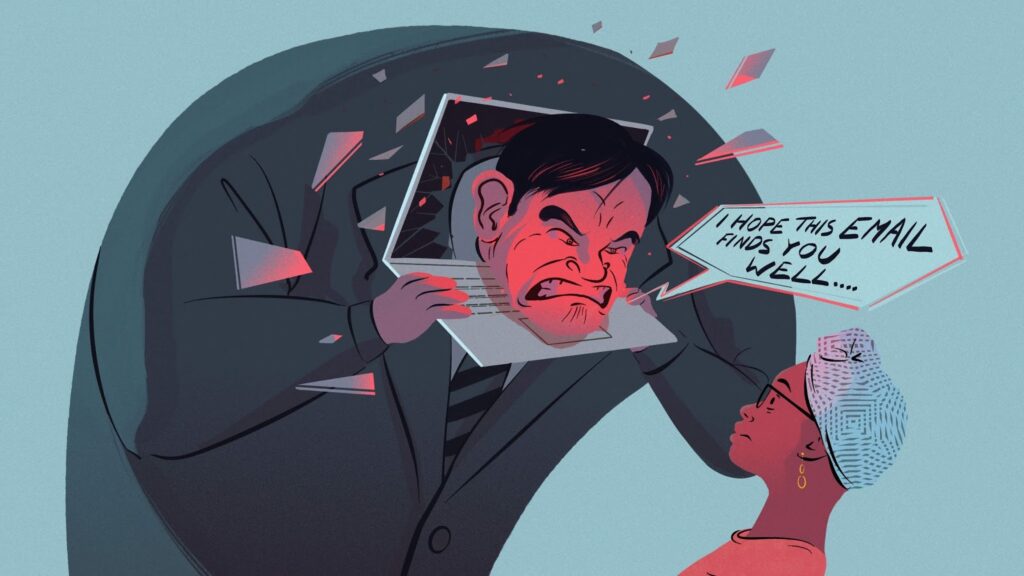It’s the day you need to send the copy for a new client. You’re satisfied with the briefing process, have done your research, and even spoken to a friend of a friend about their experience working in this industry. It’s not always easy as a freelance writer to jump between ‘worlds’, but this time, you’re feeling good. Confident, even.
You give your draft a final read through, craft a ‘here’s the first round of copy that I’ll happily edit, revise or rework if necessary’ (although this is just for pleasantries, because you know it’ll be great). And… send.
Hours go by, stalking your inbox, and nothing. No “thanks, I got it” or “oh my gosh, you’re talented” to stroke the ego. You wake up the next day and still nothing. You start to worry. At 4.55pm that day, you receive an email: “I have gone through the document and I must say, the copy still needs a lot of work. Let me know when you can talk.”
Just when I was going to shut the Mac for the day.
The client turned on me!
Oh my gosh, I’m horrible at this.
Should I even charge them, if they don’t like it?
Every freelancer has their own version of this. And these knocks are not only normal but important in a writer’s career trajectory, to help short circuit the very human ‘I’m the problem’ response. Turn this situation into a learning experience, where you reap more clarity.
Drop the stories and the ego. ‘Rejection’ is powerful. When a project goes pear-shaped, here’s what to do.
Remember, it’s an energetic match
Just because a client is unhappy, it doesn’t mean you’re a bad freelancer. It’s about if you and the client are a match, energetically – just like all relationships. Some energies jive together, others don’t. This isn’t something we learn in school. You’re not wrong, they’re not wrong; you’re just not the right match. Simple.
Often, situations go awry because you take on clients that aren’t a good fit. Freelancers are ‘yes’ people by nature and because the work ebbs and flows, it’s easy to accept every project that comes in. But you can’t be everything for everybody.
There’s great power in creating space between speaking to prospects and accepting (or passing) on the project. A simple, “I’ll get back to you tomorrow” helps you make an empowered decision, not a kneejerk scarcity response.
In every difficult situation with a client lies new information to gather about exactly who it is that you should and shouldn’t be working with. Turn this into a ‘should I take this client?’ checklist and build personas around ideal and no-go clients.
Then, make sure to communicate this to the world. Let prospective clients know exactly what you’re best at, who you serve, and why they should choose you. Your website, social media and other marketing activities be a magnet for more ideal projects.
Revisit your workflow
As a freelancer, you’re always growing. Nothing is static or set in stone. YOU are the business and therefore you call the shots. If something isn’t working, you don’t need to wait for approval at every level of the corporate hierarchy.
Trying situations with clients are opportunities to make productive changes to your workflow. For example, instead of doing one phone call for briefing, completing the questionnaire and interview, add an extra step by having them add to and approve the project document that you send over. Their mark of ownership! And you now have it.
While it might blow out the project by an extra couple of days, you save time down the track with ‘he said, she said’ conversations. This briefing document acts as the unofficial ‘contract’ for elements like tone of voice, target audience, key messaging, keywords, and how it fits with the overall communications strategy. Your copy literally answers their agreed brief.
Create a ‘my policies’ document
Yes, have a little giggle at this one, seeing as you’re the only person in the business. But a policies document serves as both a home for how you can better serve your clients, as well as a place to hold you accountable. When there’s a gap in your schedule and a project lands in your inbox that should go straight to the ‘thanks, but no thanks’ group, it’s tempting to bend the rules, just this once.
This is your reminder that it’s not better to take on the work, just because you have the time.
Grow a ‘fan list’
Freelancers don’t have the constant feedback loop of working in a team, quarterly reviews or yearly bonuses. You have a couple of contractors, a mentor and an accountant, at best, to help discern how well you’re doing.
During difficult times with clients, it’s easy to fall back on the ‘I’m not good, it’s all me’ response. This leads to either working for free to try to ‘make it up to them’ or getting frustrated and putting all the blame on them. Neither are useful when it comes to operating a successful freelance business.
Instead, take stock of how far you’ve come, talk to your support system (friends, family and fellow freelancers), and look at your ‘fan file’. This is gold when you’re going through self-doubt. Every time you receive positive feedback and clients say something great about you, add it into the file.
Feedback like: “I just read your piece and really enjoyed it. Congratulations. You’ve weaved the combination of quotes, perceptions and observations seamlessly. Really nicely written.”
Let these happy clients ‘speak’ to you in times of need.
Then, from this empowered stance, you’re better equipped to deal with the issues of the current project head-on, knowing your worth and flexible enough to handle what they need. Have the wherewithal to know when to give, when to walk away, and when to return to the brief. Always, return to the brief.
You might just find, this ‘unhappy’ client turns into your longest, most loyal contract. Freelancing is just a people business, after all.



